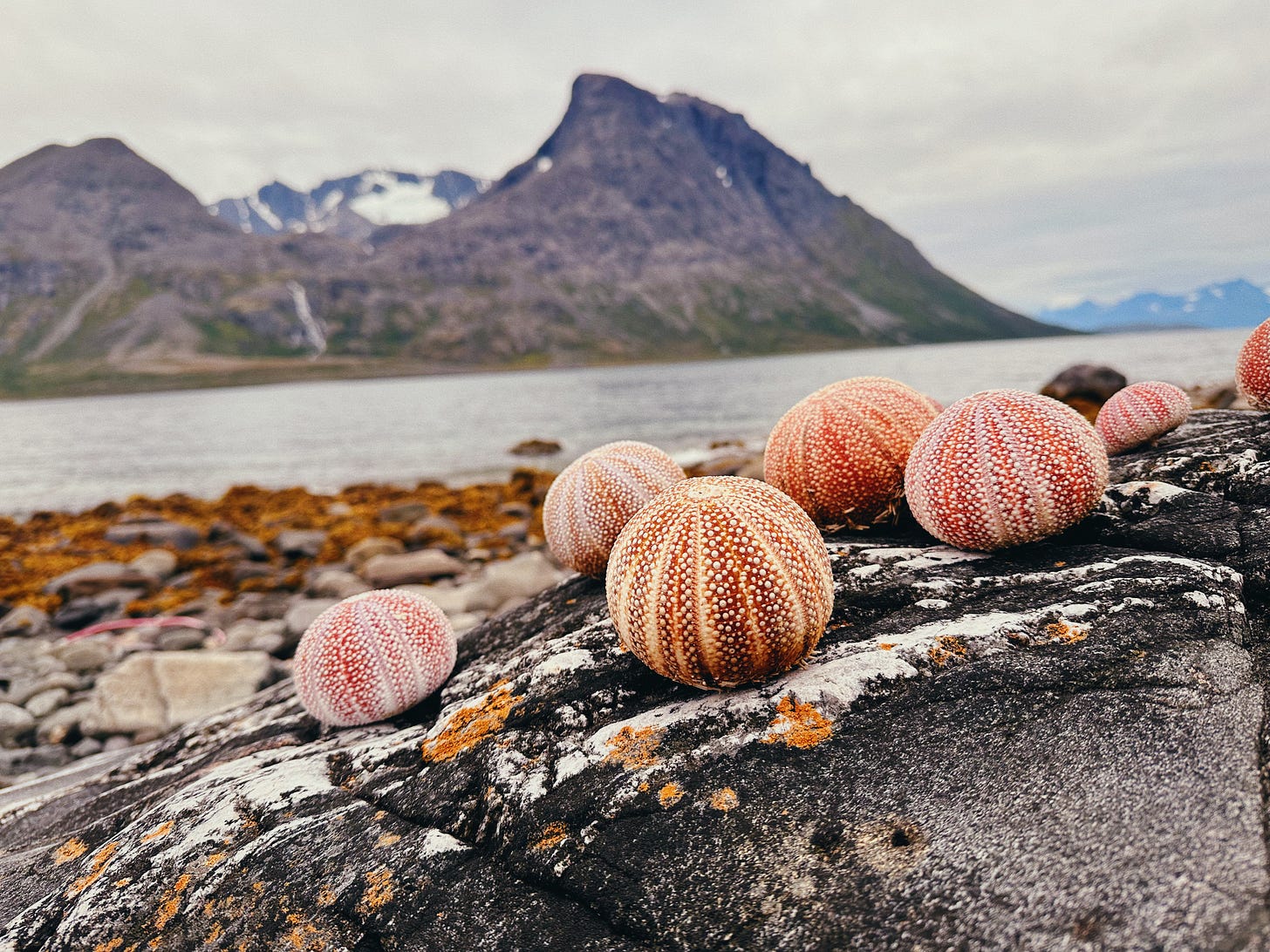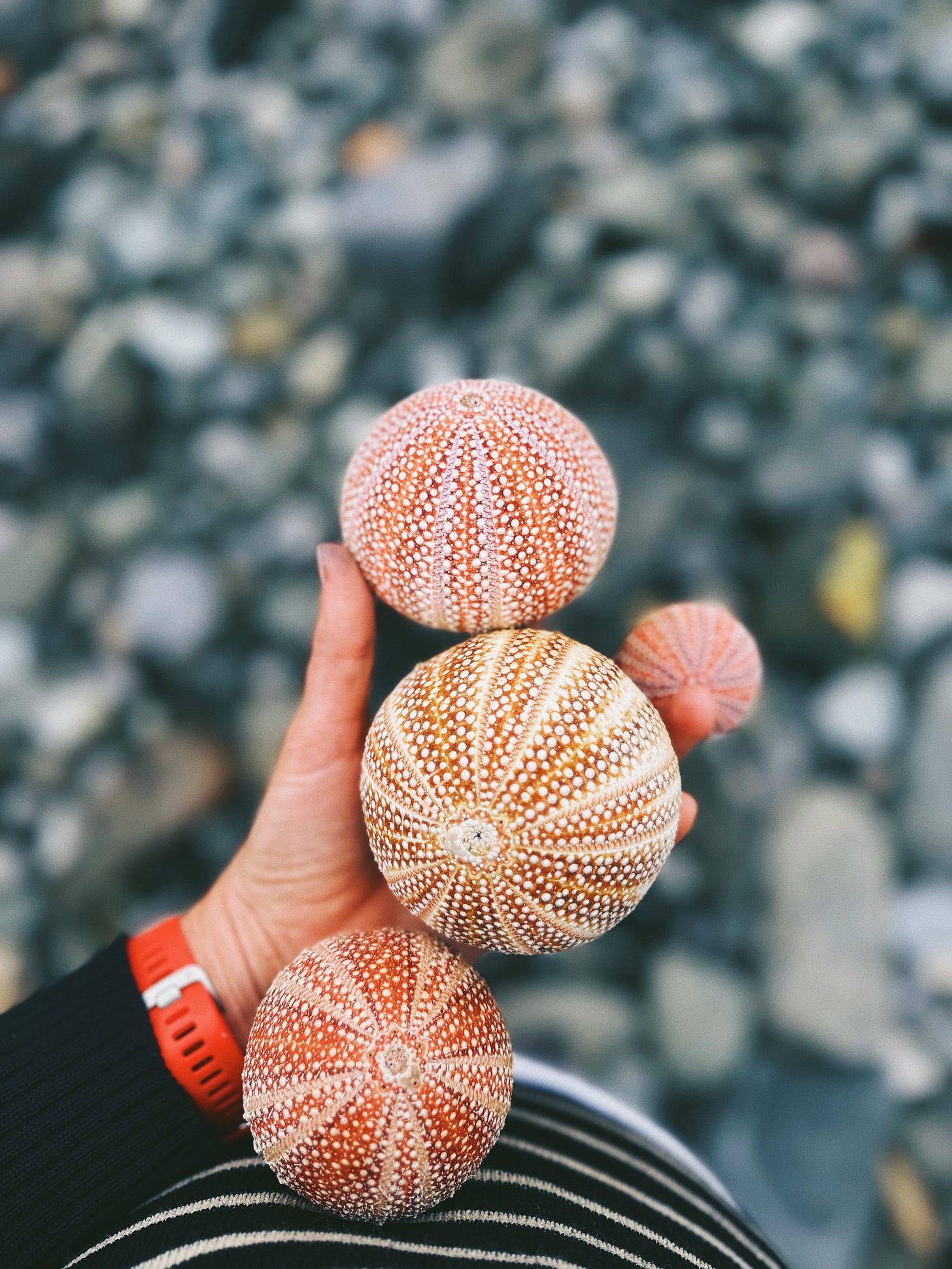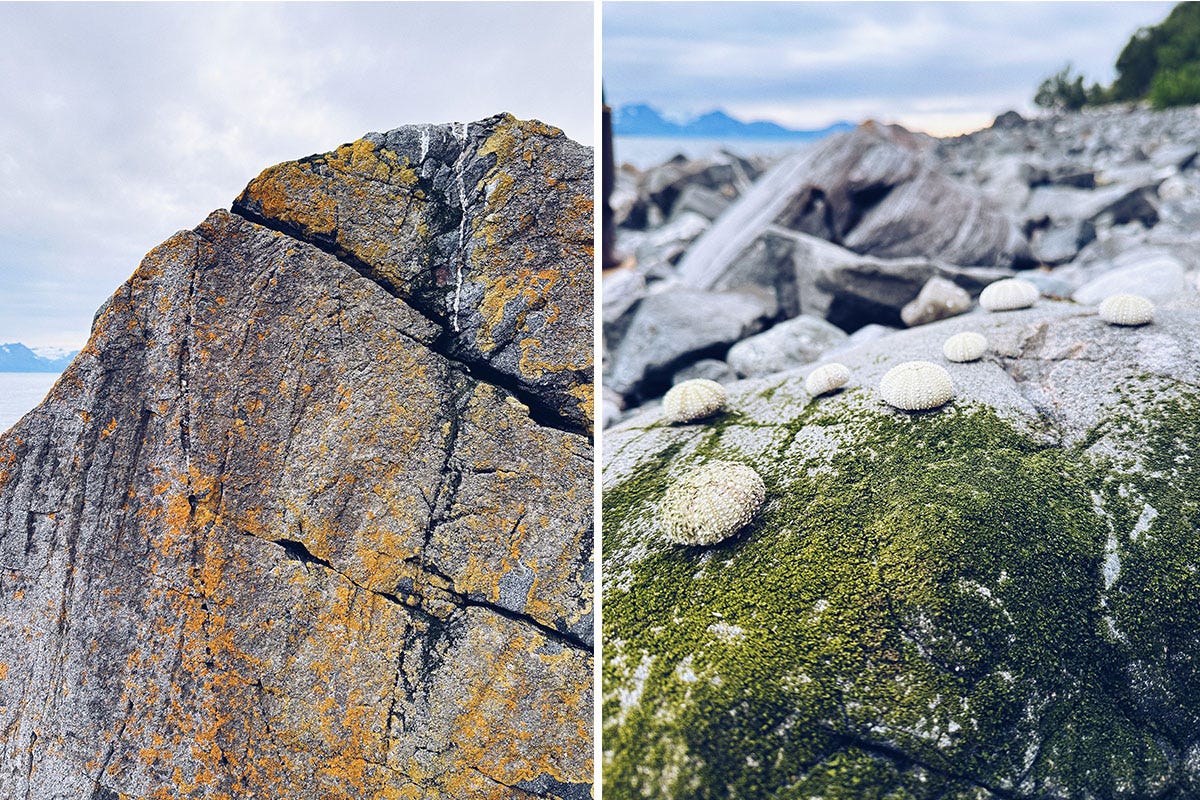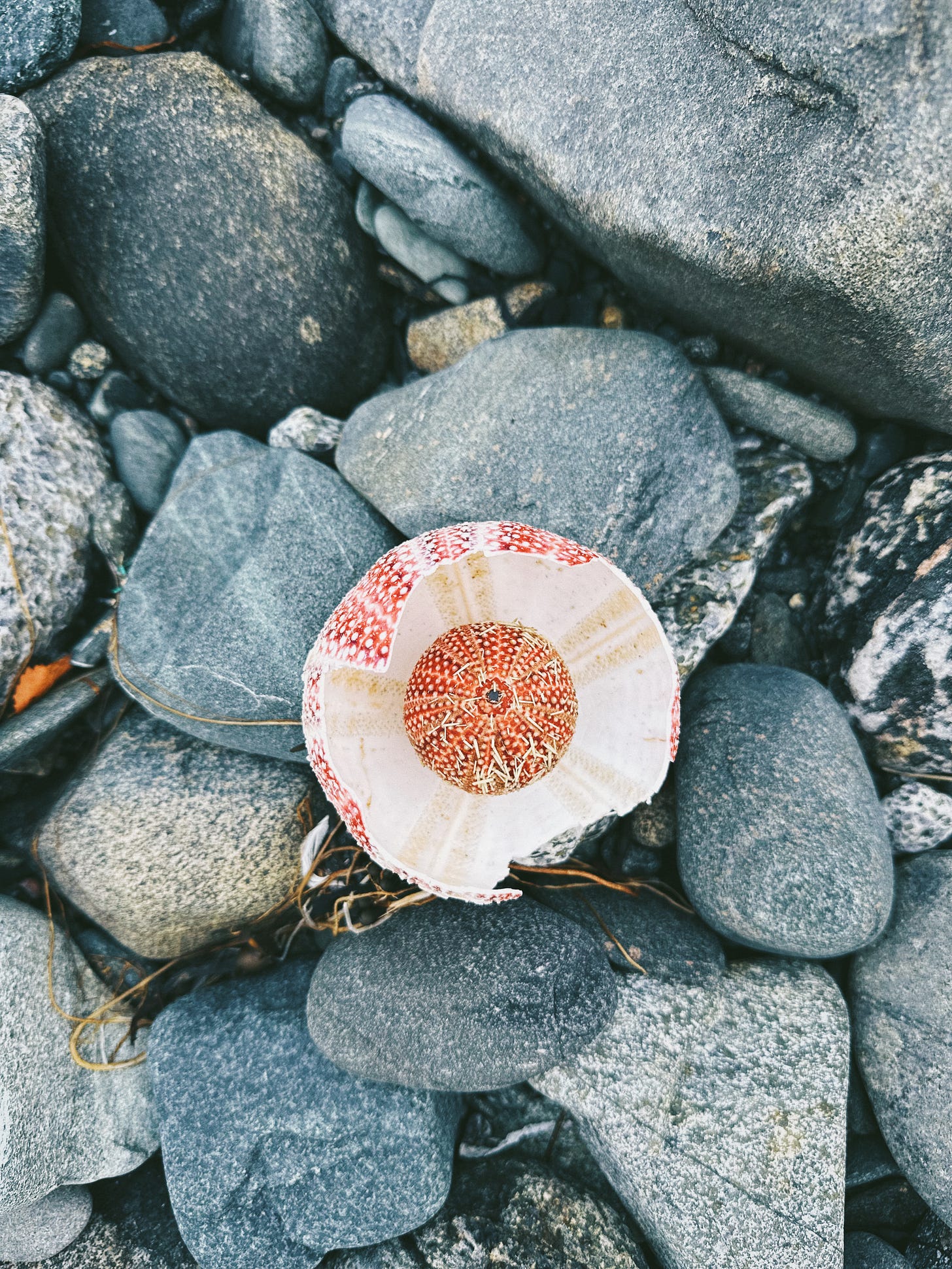Creative Fuel is a newsletter about the intersection of creativity and everyday life. If it’s your first time here: welcome! To help to make this work sustainable, please consider becoming a paid subscriber.
I’m fresh off leading my creative retreat with Hannah Viano at Singla on Arnøya, which ended earlier this week. Hannah and I have been scheming this retreat since last fall, just a little after I came home from the inaugural Singla artist residency, and it was so amazing to have it all finally come together.
Arnøya is an island in the far north of Norway. It sits high above the Arctic Circle, in the land of the midnight sun. Reindeer antlers are found in meadows and on hillsides, as the Sami use the island for their summer herding pastures before they swim back to the mainland. Fish vertebrae lie on the beach, bleached by the sun. There are rocks as flat as coasters, others perfectly round with rings like a tree. The fireweed explodes with pinkish purple. The tiny leaves of birch trees rustle in the wind. Clouds and fog blow in and out and around the islands. Fishing boats and cruise ships pass, their wake felt at the edge of land and sea.
It's an incredibly beautiful place. A difficult place to leave.
On my last night on the island, Hannah and I went on a beach walk. We slowly wandered across the rocks, keeping our eyes peeled for the bright red kråkeboller, sea urchins. The direct translation for the Norwegian term is “crow balls,” a poetic term that immediately has me imagining the image of a crow getting into these.
Without their spines, the bare shells vary in shades of red, sometimes a little on the orange side and others veering into purple. The sides are dotted in white, like a Yayoi Kusama pumpkin. These red ones are Echinus esculentus. There are green ones too, but I think that the red contrasts with the surrounding colors in a particularly beautiful way.
Finding these always feels special, a gift from the sea.
The tide brings them in, miraculously placing them at the high tide line without breaking them. If you’re lucky, you’ll sometimes spot them floating on the water, like a tiny buoy.
As we walked along, we found more than usual, most of them perfectly round despite being washed up on an incredibly rocky shore. Looking down the seaweed-strewn high tide line, there were so many that we could spot the pops of red color from afar.
If you’re a collector of things on a beach, the kind of person whose pockets are always filled with rocks and other tidbits, then you might understand how hard it is to just leave these on the ground.
You can only carry a few of these at a time in your hands, so we started to make little collections of them on various rocks. Little installations for the sea to swallow up in the next high tide.
We walked slowly and intently, each wanting to find a special beach rock to put in our pocket to take home. I was drawn to the much bigger rocks with interesting lines and crags, taking pictures of the dark yellow lichen sprawling across gray stone. With the tide out, the mustardy brown rockweed was visible, contrasting with the slate blue of the saltwater. I took far more photos than I usually do, and with each one, I could tell that I was somehow trying to capture it all, hold onto it for later.
In these final moments I wanted to inhale every smell, feel every texture, listen to every tern and gull call, drink in the entirety of the color palette. I wanted to hold onto it deeply. I wanted to implant the place into my cells.
I wanted to somehow put the entire scene—the place, the feeling—in my pocket.
The last time that I spent in my Swedish grandmother’s apartment, I did a similar thing.
It was a few years ago, when we gathered as a family for her memorial. My parents and I stayed in her apartment, a place that I have known since I was able to crawl. It never changed much in the over three decades that I knew it, and after an entire lifetime of visits, this was the last time I would ever be there—it would be sold, and new people would make it their home.
In those final days, I tried to soak in every tiny detail. I went through the space taking pictures of every room, in an attempt to capture the memories held within the walls. The off-white coffee thermos on the balcony. The colorful print above the television. Mormor’s bed. The very 1960s wallpaper in the bathroom. The lace curtains. The white lamp above the kitchen table and the blue chairs. The view out to the playground where I had spent so many summers as a kid.
I wanted to put it all in my pocket.
I printed some of those photos, but I know that last capture is not where the memories live. They are deep within, embedded at the cellular level. They were planted long ago, shaped over decades of conversation and interactions. In breakfasts at the kitchen table, in card games with my grandparents, in fika on the balcony. Memories formed through the the time spent watching, listening, conversing, feeling, existing.
When we come to the end of something, it’s so easy to want to take everything in. Soak something up in a way that ensures that we capture the moment. We want to feel like we are holding onto all those final bits before they disappear.
It feels like a particularly August type of emotion, as it’s so often how we can feel at the end of summer. One last swim, one last meal outside, one last book read in the sun. We’re trying to squeeze every single ounce of the season out, as if somehow just one more thing would help us eke out a little more before it’s gone.
But memories aren’t usually created in the final moments. They are shaped in the everyday rituals and routines, in the conversations, in the places in between. That applies when we travel, and it applies when we’re at home. You don’t necessarily define summer by the last time that you went for a swim, the last book you read, the last picnic you had, the last moment in the hammock—the memory is formed through all the swims, all the books, all the picnics, all the hammock time.
It’s the argument for being in the moment when you can, because memories aren’t defined by one final capture, they are built along the way. Memories are created from noticing, from observing, from paying attention.
To remember a place or a moment, we’re asked to do more than just pass through, engage in our surroundings in a deeper way than just by ticking off a checklist.
As much as we might like to, and as much as we might try, we can’t physically hold onto a place. We can’t put it in our pocket, and even the strongest memories can be a slippery thing. Eventually they begin to fade at the edges, the clarity softened by time.
I often think that this is what art is: the attempt to try to capture a feeling, an emotion, a moment—something without the hard and defined edges of a tangible object. As artists, we’re feeling, we’re watching we’re observing and we’re trying to put the world in our pocket.
On my last morning at Singla, Hannah and I walked down to the beach for a swim. It was a moody, rainy morning and the tide was low. I walked into the clear Arctic water, feet protected from the barnacle-covered rocks by sandals.
Looking down into the water, I saw a tiny sea star gripping to a rock. There were numerous sea urchins nestled at the bottom, these ones alive and covered in their dark purple prickly spines.
And then, a pop of red.
Somehow a sea urchin shell that otherwise would have floated to the surface had gotten stuck between two rocks. I positioned myself so that my hand was in line with the shell, and then plunged straight down to the bottom, reaching for what I had seen. For a brief second, I opened my eyes in the saltwater, just to make sure I was grabbing the right thing.
I came back up to the beach, a small, perfect red kråkeboll in my hand.
Too big for my pocket, but small enough for travel.
After I dried off and changed, I wrapped the sea urchin in several layers of paper towel and placed it in a metal food container for better protection.
It’s nestled in there now, cushioned between layers of soft clothing instead of barnacle-covered rocks. I know it might break. I know that when I finally take it out and place it on my desk, it might lose a little of its magic, as things often do when they are removed from their original surroundings.
We can’t put an entire place, an entire scene, an entire experience into our pockets.
But we will continue to try.
-Anna
I’ll be sharing a little more creative inspiration from Singla tomorrow for paid subscribers as part of the ongoing Creative Fuel series of weekend prompts + inspiration. If you too like Arctic color palettes and textures, or just supporting this newsletter, please consider becoming a paid subscriber.







Reading this bubbled up this idea that the last of's...the last river swim of the summer, the last hike of the season, the last sauna of a retreat...being a container for all those that came before. It becomes a way of holding the collective memory and feeling of all of the swims and all of the steps and views and lunches of a hike and all of the days on retreat in one place.
In the same way, the first of's holds the possibility of what's to come.
And in all of it, it's the thread of being her now - in the first of's the last of's and all that's in between - that makes any of it matter.
And I would loooove to paint one of your beach and sea urchin scenes! Echinodermata! So elegantly symmetrical!